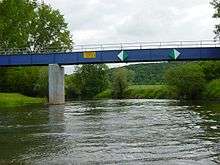Unstrut
| Unstrut River | |
|---|---|
 Bridge over the Unstrut | |
| Country | Germany |
| Basin | |
| Main source | Thuringia |
| River mouth |
Saale 51°10′33″N 11°48′7″E / 51.17583°N 11.80194°ECoordinates: 51°10′33″N 11°48′7″E / 51.17583°N 11.80194°E |
| Physical characteristics | |
| Length | 192 kilometres (119 mi) |
| Features | |
| Tributaries | Helme, Gera, Wipper, Lossa |
The Unstrut is a river in eastern Germany and a left tributary of the Saale. It originates in northern Thuringia near Dingelstädt (west of Kefferhausen in the Eichsfeld area) and its catchment area is the whole of the Thuringian Basin. It breaks out of the basin through the Thuringian Gate west of Heldrungen and, in its lower reaches, flows through Saxony-Anhalt before emptying into the Saale near Naumburg. The total length of the Unstrut is 192 kilometres (119 mi). Towns along the Unstrut include Mühlhausen, Sömmerda, Bad Frankenhausen, Artern, Roßleben, and Freyburg. The main tributaries of the Unstrut are the Gera, Wipper, Helme, and Lossa.
The countryside around the Saale and Unstrut rivers forms the wine-growing region of Saale-Unstrut. The well-known brand of sparkling wine, Rotkäppchen ("Little Red Riding Hood") is produced in the cellars of Freyburg.
Name
Strödu in Old High German means a boggy thicket, un- is a prefix to intensify the meaning, so the Unstrut region was a very swampy area. In 575, the river was called the Onestrudis, in the 7th century it was referred to as the Unestrude and, in 994, as the Vnstruod.
History
In 531, according to the Decem Libri of Gregory of Tours, the decisive battle between the Franconians and Thuringians took place along the Unstrut, which resulted in the destruction and annexation of the early medieval Thuringian kingdom by the Frankish empire. In 933 the German king Henry I fought, after a ten-year truce, against a Hungarian army in the Battle of Riade, a place near the Unstrut, but which is now unknown. His victory led to a period of peace, until the Hungarians returned in 955 and were defeated again. One of his favourite places was Memleben on the Unstrut, where a royal residence, a so-called Pfalz, palatium or villa regia, was built. He died there in 936, as did his son, Otto I, in 973. A monastery was built there in the next years, becoming one of the most important in the German realm for a short time. Its ruins may still be seen; the exact location of the palatium is not known any more.
Due to its marshy character, the Unstrut was not navigable for ships for a long time. Finally, in the years 1790–94, the river was made navigable on the orders of the Elector of Saxony. It became an important shipping lane for a century; in particular, sandstone and limestone were shipped. From 1889, when the Unstrut Railway (Unstrutbahn), was built alongside the river, the significance of the waterway as a transport route was much reduced. Although the Unstrut wine-growing region, with an area of 300 hectares (740 acres), is one of the smallest, it is quite well known.
Sights
- Historic town of Mühlhausen
- Ruined castle of Wendelstein
- Ruined abbey of Memleben
- Neuenburg Castle at Freyburg
Sources
- Gerlinde Schlenker; Jürgen Laubner (2002) (in German), Die Unstrut. Porträt einer Kulturlandschaft, Halle: Mitteldeutscher Verlag, pp. 256, ISBN 3-89812-137-2
- Hermann Größler: Führer durch das Unstruttal von Artern bis Naumburg für Vergangenheit und Gegenwart, bearbeitete Ausgabe des Originaldrucks von 1904, Dingsda-Verlag Freyburg, 2. Auflage 1995, ISBN 3-928498-04-5
- Christel Foerster, Christian Kupfer: Unteres Unstruttal, Greifenverlag 1992, ISBN 3-7352-0295-0
- Fritz Kühnlenz: Städte und Burgen an der Unstrut, Greifenverlag, 1. Auflage 1962 oder Sondereinband - Verlagshaus Thüringen 1999, ISBN 3-89683-121-6
- Christian Kupfer, Michael Pantenius: Die Weinstraße an Saale und Unstrut - Kulturlandschaft in Mitteldeutschland, Mitteldeutscher Verlag 1997, ISBN 3-932776-01-1
- novum castrum. Schriftenreihe des Vereins zur Rettung und Erhaltung der Neuenburg e.V.
- Saale-Unstrut-Jahrbuch des Saale-Unstrutvereins für Kulturgeschichte und naturkunde e. V. Druckhaus Naumburg. Erscheint jährlich seit 1996
- Andreas Schmölling, Klaus Schmölling: 200 Jahre Schiffbare Unstrut 1795-1995, Heimatverein Artern 1995
- Th. Sommer, G. Hesse: Hydrogeologie einer anthropogen überprägten Flusslandschaft - das Unstruttal zwischen Quelle und Sömmerda (Thüringer Becken) in: Jber. Mitt. Oberrhein. Geol. Ver., Neue Folge 84, Stuttgart 2002
- Sagen der Unstrut-Finne-Region. Bearbeitet von Frank Boblenz (Sömmerdaer Heimatheft; Sonderheft 1). Sömmerda 1999.
- Unstrut Sagenbuch. Die schönsten Sagen von der Quelle bis zur Mündung. Herausgegeben von Harald Rockstuhl. Bad Langensalza 2007. ISBN 978-3-938997-81-9